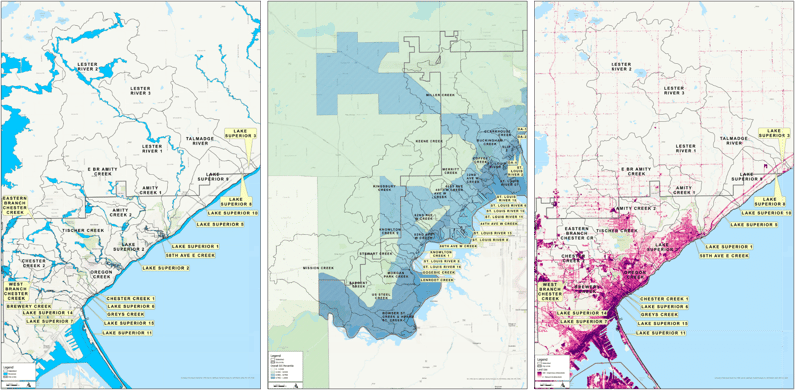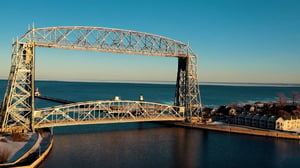Challenge
The City of Duluth, Minnesota, which hosts the largest harbor in the Great Lakes, faces complex stormwater management challenges stemming from its unique history and distinctive natural and urban landscape. Many neighborhoods in Duluth were constructed on steep hills, and industrial areas were established along Lake Superior's shoreline without proper stormwater infrastructure.
Recent extreme events have impacted the City's communities and infrastructure and made the need for significant improvements to its aging infrastructure more evident. Multiple other factors, including decades-old rerouting of streams underground, floodplain management, social vulnerability, urban pollution, and water quality degradation add to the difficulty of addressing evolving environmental concerns. SEH is leading these types of stormwater management and resiliency efforts and sharing with the world what can be done.
Visit the Duluth Area Chamber of Commerce's historical resource page to learn more about the rich history of Duluth and its impact on the City's development.
Solution
In collaboration with the City of Duluth, SEH developed a comprehensive Stormwater Management and Resiliency Plan. This initiative responds to the need for infrastructure planning that adapts to climate variability, addresses evolving risks, and integrates social and environmental considerations. The goal is to clearly identify stormwater vulnerabilities then develop and implement projects that enhance infrastructure and community resilience.

Strategic Approach and City-Wide Study
The City-wide analysis, which was the first of its kind, contained an extensive study that evaluated multiple parameters, including water resources, existing infrastructure, socioeconomic factors, and other risks relevant to developing a Watershed Priority Matrix. The analysis emphasized the significance of implementing flood risk reduction projects that also provide added benefits, including improved water quality, ecosystem restorations, and increased community involvement.
SEH employed Geographic Information Systems (GIS) alongside diverse datasets from City, State, and Federal sources and developed specific metrics to create a detailed plan. This began with marking the City's first phase to establish a prioritization framework that is both clear and actionable. The scope of the plan includes:
- A thorough characterization of the City’s 67 watersheds and sewersheds
- An analysis of environmental parameters including land use, floodplains, impaired streams, trout streams, and the state of existing infrastructure
- A focus on social vulnerability, environmental justice, and the prioritization of critical services, ensuring a study that spans community-wide needs

Focused Watershed Stormwater Vulnerability Assessment
A focal point of the plan was the 32nd Avenue West Creek Watershed study, located primarily within the Lincoln Park neighborhood. The study included a comprehensive aerial survey, on-site physical assessment of the infrastructure's existing conditions, photogrammetry and GIS data analysis, and detailed hydraulic and hydrologic modeling. The study also included the analysis of county-specific precipitation projections developed by the University of Minnesota Climate Adaptation Partnership to assess how climate change impacts local communities and vulnerable populations.
Community Engagement
Community involvement played a pivotal role in the plan's development process. The City staff took several actions to reach out to residents, businesses, and local organizations within the 32nd Avenue West Creek Watershed and the Lincoln Park neighborhood to encourage participation in a public stormwater resiliency workshop. This workshop served as a platform for dialogue, allowing the City to communicate ongoing efforts to mitigate flooding, explore residential-scale green infrastructure ideas, and gather firsthand accounts of residents' experiences with flooding. This outreach was exceptionally important in aligning the plan with community needs and garnering support for proposed plans moving forward.
At the conclusion of the presentation, attendees were encouraged to talk to City staff about stormwater issues they experienced in the watershed. Detailed map boards of the neighborhood and model results were available at the meeting to help residents communicate with City staff about specific locations where stormwater issues had been observed. Additionally, comment cards were provided for people to write down their observations if they did not feel comfortable speaking, ensuring every voice was heard.
Enhancing Funding
The team researched a variety of potential funding sources, including those from Federal, State, and non-governmental organizations. The funding sources identified pertain to water quality improvements, flood and hazard mitigation, climate adaptation and resilience, Great Lakes restoration, and overall infrastructure improvements.
SEH developed an in-depth funding matrix to further the City's ability to secure funding for the implementation of critical projects. This tool details each program's application deadlines, eligibility and scoring criteria, reporting obligations, and matching fund requirements. By aligning projects with the most suitable funding opportunities, the City is positioned to maximize funding, ensuring the implementation of critical infrastructure improvements.
Project
Duluth Stormwater Management and Resiliency Plan
Location
Duluth, Minnesota
Client
City of Duluth
Features
- Development of new stormwater management baselines
- Utilized actionable science to inform decision making
- Geographic Information Systems (GIS) metadata analysis
- Community resiliency workshop identified specific stormwater concerns and gathered resident experiences
- City-scale stormwater infrastructure resiliency study
- Watershed-scale stormwater vulnerability assessment
- Identification of vulnerabilities and climate adaptation analysis
- Comprehensive funding matrix devised to identify funding for critical projects
Services
- Stormwater engineering
- Flood risk mitigation
- Water resources engineering
- Community resiliency
- Funding
.png?width=113&name=SEH_Logo_RGB%20(1).png)
